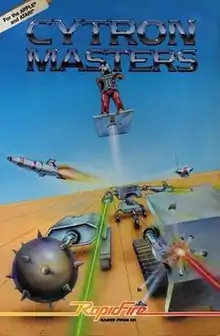| Cytron Masters | |
|---|---|
 | |
| Developer(s) | Ozark Softscape |
| Publisher(s) | Strategic Simulations |
| Designer(s) | Danielle Bunten |
| Platform(s) | Apple II, Atari 8-bit |
| Release |
|
| Genre(s) | Real-time tactics Real-time strategy[1][2] |
| Mode(s) | Single-player, Multiplayer |
Cytron Masters is a computer game by Danielle Bunten released for the Apple II and Atari 8-bit family in July or August 1982.[3] Developed by Ozark Softscape and released by Strategic Simulations, Cytron Masters is one of the earliest computer games that can be considered a real-time strategy game,[1][4] or a real-time tactics predecessor to the genre,[5] requiring the players to build up their forces in order to win.
Gameplay
In the game each player takes the role of the commander, represented on-screen in Command Centers located on opposite sides of the screen. Scattered around the screen are eight "generators" that produce energy. The energy produced by these generators is the resource in the game, similar in function to the more tangible resources gathered in modern RTS games. Energy can then be "spent" to produce the Cytrons, robot warriors, as well as using it to move them about, fire, and other duties.
The playfield consists of a twelve by six grid of possible locations, with the command centers at the (1,3) and (12,3) locations. Five different types of Cytrons can be built and moved about the grid. Shooters fire at the closest of any enemy units with a three-space range, mines detonate when an enemy approaches, bunkers absorb damage, and missiles fly up and over the battlefield to detonate at a selected location. The fifth unit, the Commander, relays commands from the Command Centers out to the units in the field.
Gameplay is somewhat chess-like, a battle for position. Bunkers and mines become important along the front lines, protecting friendly units from attack while they are developed forward.
Reception
Mark Botner reviewed the game for Computer Gaming World, and stated that "Cytron Masters is an exciting game offering multiple levels of play with variations to suit the individual: Play on all levels guarantees an action-packed episode of futuristic combat."[6]
Chris Smith reviewed SSI's RapidFire Line in The Space Gamer No. 59, and commented that "Cytron Masters requires a bit of tactical know-how, and its real-time command system gives it a slight arcade feel. I think this is the perfect combination of arcade and board game."[7]
In a 1992 survey of science fiction games, Computer Gaming World gave the title two of five stars.[8]
References
- 1 2 Barton, Matt. "The History of Computer Role-Playing Games Part 2: The Golden Age (1985-1993)". Gamasutra. Retrieved October 16, 2017.
SSI's most famous non-CRPG game is probably Cytron Masters (1982), one of the first (if not the first) real-time strategy games.
- ↑ Moss, Richard (September 15, 2017). "Build, gather, brawl, repeat: The history of real-time strategy games". Ars Technica.
- ↑ Sipe, Russell (July–August 1982), "Hobby and Industry News" (PDF), Computer Gaming World, pp. 1, 4
- ↑ "Game Design Memoir by Dani Bunten Berry". Archived from the original on 12 March 2009. Retrieved 13 July 2008.
- ↑ Scott Sharkey. "Hail to the Duke". 1UP.com. Archived from the original on 2004-09-13. Retrieved 2011-03-01.
- ↑ Botner, Mark (September–October 1982). "Cytron Masters: The View From a Play Tester". Computer Gaming World. Vol. 1, no. 6. pp. 30, 45.
- ↑ Smith, Chris (January 1983). "SSI's RapidFire Line: Featured Review". The Space Gamer. Steve Jackson Games (59): 14–15.
- ↑ Brooks, M. Evan (November 1992). "Strategy & Wargames: The Future (2000-....)". Computer Gaming World. p. 99. Retrieved 4 July 2014.